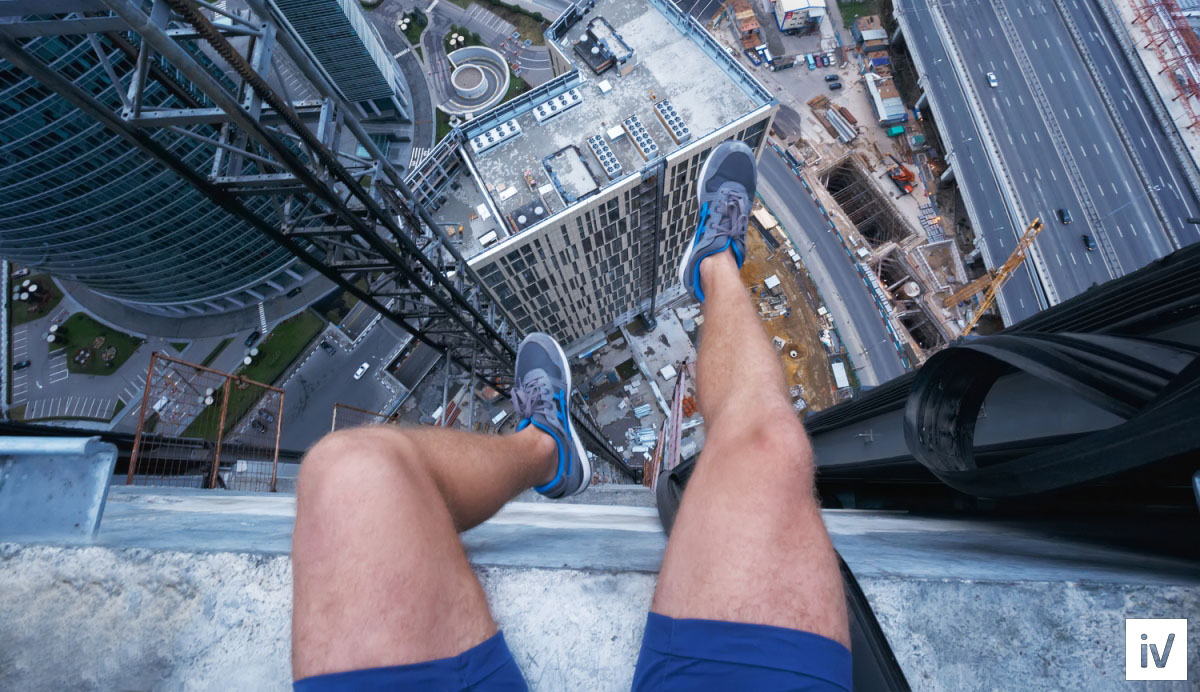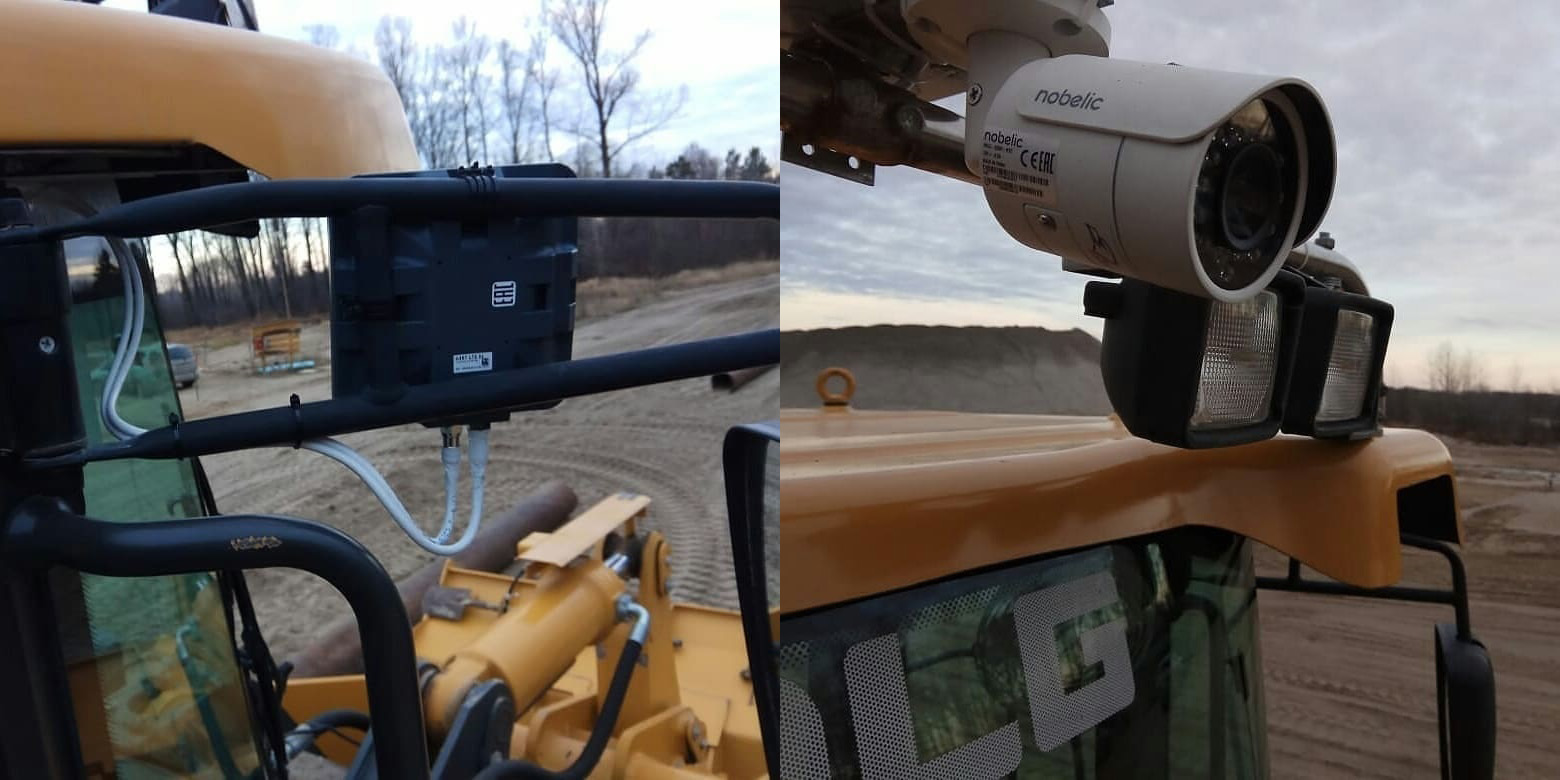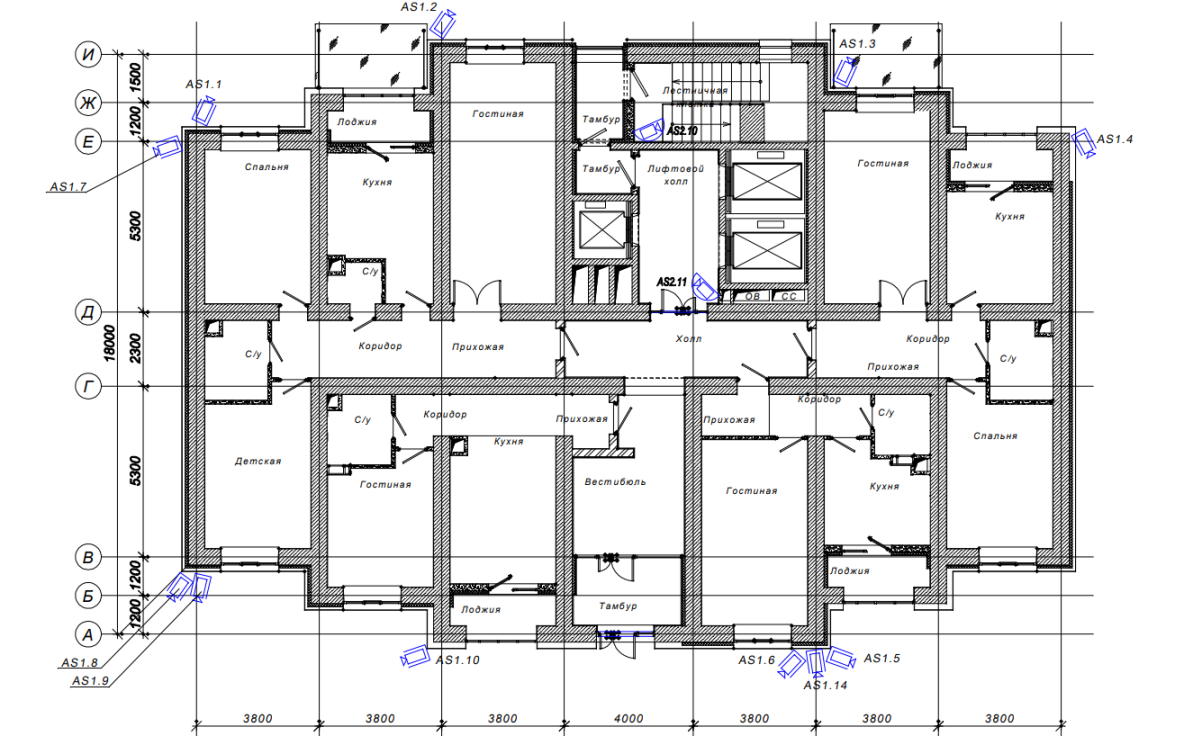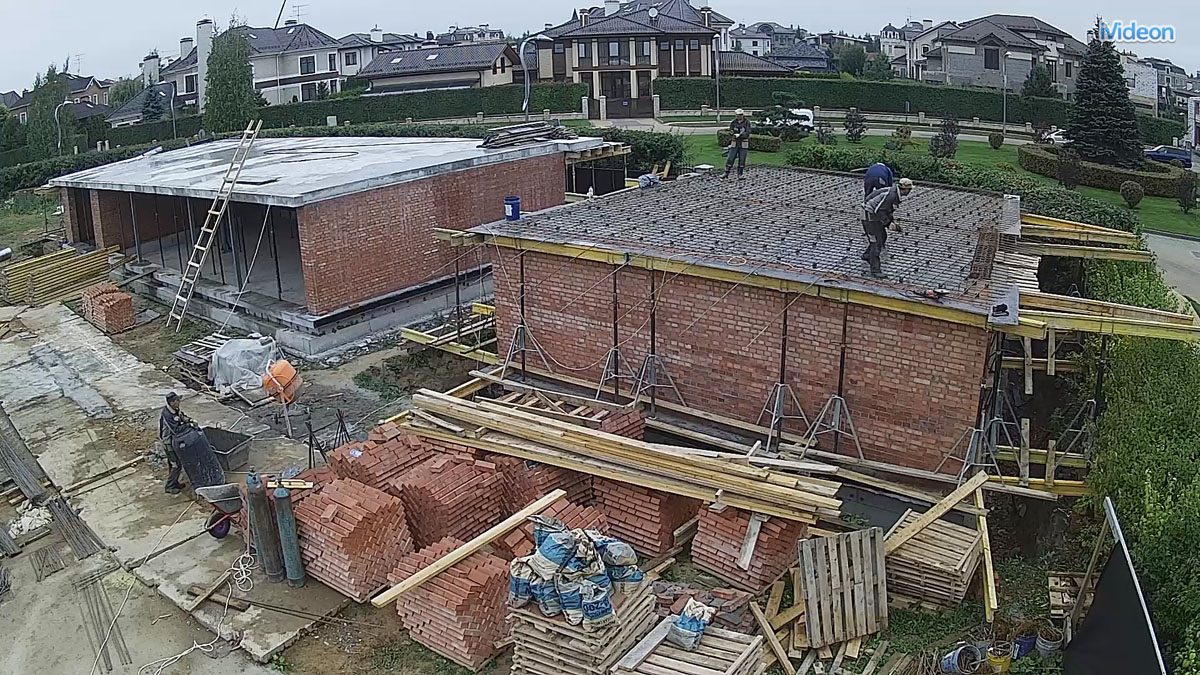Babylonian row: 5 security issues in the construction business

In the courtyard of one of the houses under construction, a settlement of construction workers appeared: dozens of typical change houses with 8 beds, a row of blue toilet cubicles, separate buildings of the dining room and bathhouse. In the first month, 500 people went to work in a comfortable town. A month later, it became a hundred people more - newcomers to the construction profession did not own, but felt comfortable.
An imperfect security system by passes or simply “by eye” is easily permeable: builders sell a bed to friends from Central Asia. The guards through their fingers look at the same as two drops of dew workers. In the best case, the developer incurs indirect losses, in the worst case, the newcomers will endure everything that is bad, arrange a storm or burn themselves inadvertently along with housing.
A place of work is a place of life. There are no visible violations. Employers can register and settle foreign workers on the territory of the enterprise, for example, in a warehouse, in construction trailers, even in a tent made of oilcloths and birdhouse boards. Further, a complex construction control system comes into force, which in practice works badly.
As the industry grows, so does the scale of crime. Construction, including housing, is criminalized nowhere else. A series of troubles stretched from Vostochny Cosmodrome, where they tried to add a “dry law” to measures to combat “putting feet on things”, to national projects with gas pipelines “earth power” and hundreds of millions of rubles of damage .
This is not to say that there are no safety systems at construction sites. All facilities under construction in Russia are equipped with cameras. This is not only a requirement of state and social programs (of the known ones - “ Safe Region ”), but also a powerful tool to increase customer loyalty: transparency of construction processes is credible.
Video surveillance has become a cheap but often useless security tool - even though it sees an eye, its teeth are numb. Without “brains” in the cameras, built-in “smart” firmware, the construction site is like a house with closed doors without locks: not everyone will check the door handle, but those who take the risk will be pleasantly surprised.
Despite all the advances in the industry of advanced intellectual security, there are still stumbling blocks that prevent construction business owners from investing in technology. Our video surveillance experts interviewed developers and identified five barriers to the digital transformation of the construction business.
1. The total cost of video equipment

The larger the construction, the more expensive the video surveillance system. One of the world's most expensive security systems will appear at the Leeza Soho Tower in Beijing. Source
A few guards are cheaper than cameras with video analytics, right? In fact, this data is hopelessly outdated. In 2011, a video surveillance system cost 100 000 ₽: one camera with zoom and image detail - 50 000 ₽, an attached server for 30 000 ₽ and, of course, installation (up to 30 000 ₽). Over 10 years, the cost of a typical system fell 10 times. Today, to get started, you do not need a dedicated server and complicated setup - just spend power and the Internet.
There have been significant improvements in surveillance cameras in recent years. High-definition matrices appeared in the devices, providing image brightness and color shooting at night. One Nobelic NBLC-3261Z-SD cloud camera with remote adjustment of focal length and viewing angle through a varifocal motorized lens replaces several cameras of the previous generation.
Connecting one CCTV camera to a cloud service is traditionally expensive: the most affordable option through a DVR is from 1,500 rubles per channel. In reality, they often use network video recorders, PCs with a powerful processor or cameras with built-in cloud firmware, and the price will increase by 4-5 times. With an Ivideon Bridge device, connecting one channel (camera) will cost the company only 375 rubles per device. But this is not all: the business does not bear any costs for installation and replacement of equipment - the video surveillance system is already installed, the cameras are mounted and working. Thus, a typical video surveillance system turns into a cloud one order of magnitude cheaper - we are talking about savings in the amount of more than 100,000 rubles.
For example: the traditional way to connect 16 cameras to a cloud service at a construction site can cost the company about 124,800 rubles, taking into account the replacement of equipment and installation work: 16 cameras x 6500 = 104,000 rubles for equipment, installation work at least + 20%. This means that connecting one channel in the traditional way costs about 7,800 rubles.
2. The cost of video monitoring

Third-party video monitoring adds additional monthly costs to operators. It’s great to control the construction site using video, but no security guard, foreman or manager will do this effectively for more than an hour. If you have seven cameras, one person will need seven hours to watch an hour of video.
Intelligent security systems solve the problem. Systems collect and analyze data from multiple streams, which AI can correctly classify faster than a human operator, reducing the time to get the most clear picture of problems at the construction site.
 Zaur Abutalimov, Ivideon Product Director
Zaur Abutalimov, Ivideon Product Director Computer vision at a construction site helps to deal with violations. Face recognition class systems compare photos of employees with a database that is replenished with the help of employees of the developer. Another example is to analyze people's emotions in order to understand how emotional exhaustion affects job satisfaction.
To save time and effort, it is extremely important to properly configure and send managers reports with complete information about the goals achieved. If the object is set to control the passage of personnel and take into account working hours, the report should contain information on how many people were declared to work and how much came in fact, how much time they worked before they left the construction site.
The cost of video analytics fell more than the price of equipment, and the quality increased proportionally. In 2009, the price tag rose to $ 10,000 per channel. For a compact modular platform for server analytics, it was necessary to pay about $ 15,000. In addition, the systems themselves were discredited , and consumers were disappointed with the mismatch of advertising promises with real results.
In 2019, all the main analytics modules for one channel will cost $ 100. The quality of the modules confirms the unprecedented growth rate of implementation among the companies that were the first to realize the role of analytics - the banking sector, retail, and the processing industry.
3. No Internet and Wi-Fi at the construction site

Video surveillance is now on the tap. Source
The cable network is not always available at the construction site or repair facilities. However, this does not mean that surveillance systems will not work at all.
The solution to this problem is the Nobelic ZLT P11 antenna with a modem and a router for receiving and simultaneously amplifying a 2G / 3G / 4G signal. Using one SIM card of any mobile operator, you can connect several cameras even in the territory of weak signal reception.
The antenna is mounted on the street with a bracket, with the front side oriented to the base station of the mobile operator. The low weight of the device allows you to mount it anywhere. Wi-Fi router is placed indoors. The distance between the antenna and the router can reach 50 meters. Cameras are connected to the antenna via cable, as well as via Wi-Fi - over ten surveillance cameras will work wirelessly.
A similar solution is even installed on a mobile crane to patrol the construction site using a PTZ camera that supports remote control of direction and zoom. In this case, at each turn of the crane, the antenna receives a signal from a new tower.

Source
You can solve the food situation with the help of improvised means. The object in the photo is the base of the “road workers” directly on the highway, without direct power supply and access to a “normal” outlet. Equipment: two cameras, a metal shield IP54, 4G modem with unlimited internet, a router, an antenna and some electronics for voltage regulation. The power comes from a car battery, which is charged once a day by a diesel generator.

Source
The equipment is also part of the construction - using the example above, a cloud-based video surveillance system with duplication of the archive into the cloud and installed directly onto the grader onto an SD card. The project used a professional MikroTik router and an omnidirectional LTE antenna of the MIMO standard. The grader has 2 batteries of 12 V each (output 24 V), therefore a lowering circuit was used from 24 to 12. There is a reverse situation when there is a low voltage problem: when the engine starts, the battery power critically subsides - it is solved by installing stabilizers that raise the voltage with 4 volts.
4. Focus on erroneous goals
“- We need to draw seven red lines. All of them should be strictly perpendicular, and in addition, some need to be painted in green, and some more - transparent. Do you think this is real? ”( C )
To build a video surveillance system inside a building or around a construction site is not an easy task. Before setting expediency into the equation of calculation, you need to include answers to the questions: where, whom and what do we want to see, when to look? Answers fundamentally change the video surveillance scheme.
Good planning is crucial. To let an object only by a pass is the wrong target. The pass can be lost, forgotten, faked, transferred to another. To let only those with a face that matches the model in the database onto the object is the right task to solve.

A typical plan for the placement of equipment and cable routes in a newly built residential building. Source
One of the biggest mistakes at construction sites is the presence of “blind spots”. The developer does not know at what point to hang the camera. The camera set high has a higher coverage area, but can the system recognize the face at this distance?
Another important aspect of commissioning is the cabling between devices. In the past, the traditional PoE twisted-pair cable standard limited the distance between devices to 100 meters. With the new ePoE (Extended Power over Ethernet) technology, the signal goes through a 10-megabit channel to a distance of more than 800 meters or a 100-megabit channel to a distance of up to 300 meters.
ePoE is the best solution for large-scale construction projects, apartment buildings, on sites with complex multi-level layout and diverse engineering communications. The technology allows you to quickly build huge distributed networks and significantly increases the distance between the IP camera and the switch. Equipment costs will decrease - fewer switches and DVRs; the indicator of antifragility will increase - the system's resistance to the effects of sudden external factors.
5. Control over control

Real-time construction of a cottage village - broadcast screenshot
In real estate, no one is safe from failure. Major problems can arise in any, even large companies. In order not to become a builder with Jonah’s syndrome (everyone gets into trouble as soon as the client becomes), you need to prepare in advance, otherwise it will be too late to remember about video surveillance and fight for your reputation.
Video is not only a means of control. Record - a strong argument in economic disputes, evidence in court, a tool for resolving conflicts with customers. But there is a nuance reminiscent of the judgment of the god of the dead: just as not every heart is heavier than a pen, so is the record of the discord.
 Alexander Popov, Ivideon video surveillance systems engineer
Alexander Popov, Ivideon video surveillance systems engineer
The legal weight of a video depends on how you record it. Not least, therefore, cloud-based video recordings today receive encryption and a watermark to guarantee the immutability and integrity of the original material. The court is conducting an examination, which should prove the absence of changes in personnel.
If law enforcement agencies cannot immediately obtain the necessary recordings, they often have the right to confiscate the entire video surveillance system or, in principle, refuse to use video. It’s important to note that in cloud video surveillance, exporting recordings is easier. Often passwords from cameras or DVRs are forgotten, and in the cloud, recording will be available in two clicks. In addition, the record is guaranteed to be preserved. If the attackers break the cables, burn the camera or take it with them, the last moments, while they were connected to the Internet, will remain in a reliable remote storage.
The best way to protect yourself is openness. Live broadcasts, available for viewing to thousands of customers, form the image of a sincere, friendly, cooperation-oriented developer.
Clients do not break into the overheated housing market - you have to fight for buyers. Live video adds confidence to owners, attracts new customers and disciplines the builders themselves.
Finally, cameras in new buildings over time can be installed on an ongoing basis already for yard and drive-in video surveillance with data transfer to security posts.
Video surveillance at a number of facilities must be established by law: for example, according to the Order of the Government of Moscow of July 20, 2007 No. 1529-RP and the Order of the Deputy Mayor of Moscow in the Government of Moscow of March 27, 2007, 53-RZM p.2.2, video surveillance is designed at mass facilities Housing created at the expense of the city budget.
Finally, video surveillance systems and video analytics are invariably present at objects with a massive presence of people and are associated with anti-terrorist protection requirements.
Therefore, it is not surprising that the construction sites have become one of the most numerous publicly available Ivideon TV broadcasts on the site.
The first large-scale construction in the world ended in a mixture of languages, strife and the fall of the Tower of Babel. Over the past thousands of years, the construction industry has not become safer - on the contrary, the business has added risks and problems.
The main problem is not in finance and technology - the market is ready to offer a solution for any task and for every wallet. The barrier was a low level of knowledge about the capabilities of video analytics.
And this is a double-edged pain - customers do not know that the cameras have “stepped” far beyond the standard model, in which the blind-eyed guard looks at a dozen monitors, and the suppliers do not report new solutions, operating schemes that have been tested for years.
There are two ways out of the deadlock: leave everything as it is and move forward in the general flow, rapidly breaking away from other industries, or rely on projects of the cloud-based Video Surveillance as a Service cloud model.
All Articles